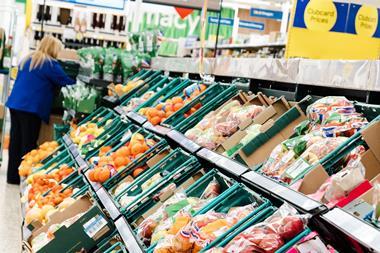The DoH is proud of its 5-a-day campaign which is designed to encourage consumers to eat five 80g portions of fresh fruit and veg a day.
However, Tesco, Sainsbury and Somerfield have all declined to use the government logo. Each is, instead, continuing with its own five-a-day project, at the same time saying they fully support the government initiative.
Hamish Renton, Tesco business planning manager for fresh produce, says the chain has not ruled out signing up to the government logo. But, he says, its own two-year campaign has moved away from being generic to specifically promoting the claims made for cancer prevention with the consumption of five portions of fruit and veg a day. And its campaign is being run in association with Cancer Research UK.
Tesco is still in talks with the DoH to look into ways it would consider using the government logo, he adds.
Sainsbury, however, says the government logo is too restrictive because it can only be applied to fresh fruit and veg products that have no added salt, fat or sugar.
A spokeswoman says: "Our customers found it useful to know what other things could count towards their portions, like ready meals. In addition, the DoH logo only applies to England, while we need a logo to go across all our stores."
Somerfield says simply that it is not prepared to abandon the investment it has made in its own campaign. A spokesman says: "We've invested a lot of time and money in creating our own and a new logo might confuse our customers."
To add to the confusion, leading food manufacturer Heinz intends to continue with a campaign that it too is calling 5-a-day, even though the products would not qualify under the government scheme. For example Heinz says that a serving of spaghetti in tomato sauce counts as one portion.
So, with a wide range of logos, some of which encompass a wide variety of products, will the 5-a-day message simply be lost in a sea of confusion? Douglas Henderson, chief executive of the Fresh Produce Consortium, doesn't think so. He says it was to be expected that some retailers would want to use their own logos. "We don't live in a Stalinist society, you can't line people up and say you will do this. Being realistic, companies will want to use their own interpretations."
He acknowledges that the different logos may produce an element of confusion, but says the message behind them is clear. However, with Sainsbury and Heinz each applying its logo to food with added fat, salt and sugar, is that message consistent enough?
The Consumers' Association, for one, is calling on the government to clarify the situation, while the DoH cheerfully demonstrates the art of spin by saying the amount of debate generated by the issue is helping to raise people's awareness. The spokeswoman adds that the department is considering whether to include composite and processed foods within the scheme, as Heinz and other suppliers are calling for.
At the end of the day, if people are eating more fruit and veg, does it matter? The Food and Drink Federation's Kate Snowdon says as long as the extra ingredients are considered as part of a balanced diet, composite foods should be included. "It's about encouraging people to eat more fruit and veg, as long as they know they shouldn't eat too much of the ones with salt, sugar and fat."
What is important is that the communication is clear and that consumers get the message. As Somerfield says: "There should be no scope for confusion if we're doing a good job in communicating the message."
{{ANALYSIS }}
However, Tesco, Sainsbury and Somerfield have all declined to use the government logo. Each is, instead, continuing with its own five-a-day project, at the same time saying they fully support the government initiative.
Hamish Renton, Tesco business planning manager for fresh produce, says the chain has not ruled out signing up to the government logo. But, he says, its own two-year campaign has moved away from being generic to specifically promoting the claims made for cancer prevention with the consumption of five portions of fruit and veg a day. And its campaign is being run in association with Cancer Research UK.
Tesco is still in talks with the DoH to look into ways it would consider using the government logo, he adds.
Sainsbury, however, says the government logo is too restrictive because it can only be applied to fresh fruit and veg products that have no added salt, fat or sugar.
A spokeswoman says: "Our customers found it useful to know what other things could count towards their portions, like ready meals. In addition, the DoH logo only applies to England, while we need a logo to go across all our stores."
Somerfield says simply that it is not prepared to abandon the investment it has made in its own campaign. A spokesman says: "We've invested a lot of time and money in creating our own and a new logo might confuse our customers."
To add to the confusion, leading food manufacturer Heinz intends to continue with a campaign that it too is calling 5-a-day, even though the products would not qualify under the government scheme. For example Heinz says that a serving of spaghetti in tomato sauce counts as one portion.
So, with a wide range of logos, some of which encompass a wide variety of products, will the 5-a-day message simply be lost in a sea of confusion? Douglas Henderson, chief executive of the Fresh Produce Consortium, doesn't think so. He says it was to be expected that some retailers would want to use their own logos. "We don't live in a Stalinist society, you can't line people up and say you will do this. Being realistic, companies will want to use their own interpretations."
He acknowledges that the different logos may produce an element of confusion, but says the message behind them is clear. However, with Sainsbury and Heinz each applying its logo to food with added fat, salt and sugar, is that message consistent enough?
The Consumers' Association, for one, is calling on the government to clarify the situation, while the DoH cheerfully demonstrates the art of spin by saying the amount of debate generated by the issue is helping to raise people's awareness. The spokeswoman adds that the department is considering whether to include composite and processed foods within the scheme, as Heinz and other suppliers are calling for.
At the end of the day, if people are eating more fruit and veg, does it matter? The Food and Drink Federation's Kate Snowdon says as long as the extra ingredients are considered as part of a balanced diet, composite foods should be included. "It's about encouraging people to eat more fruit and veg, as long as they know they shouldn't eat too much of the ones with salt, sugar and fat."
What is important is that the communication is clear and that consumers get the message. As Somerfield says: "There should be no scope for confusion if we're doing a good job in communicating the message."
{{ANALYSIS }}








No comments yet